Climate Change Impacts on Irrigation Requirements of Preserved Forage for Horses under Mediterranean Conditions
Abstract
1. Introduction
2. Materials and Methods
2.1. The Study Area
2.1.1. Forage
2.1.2. Soil Data
2.1.3. Climate Data
- Historical monthly data series for the reference period (1971-2000) were obtained from the nearest weather stations available: precipitation from the Barragem de Magos weather station (38°59′ N; 8°42′ W; 43 m a.s.l., the nearest weather station); maximum and minimum air temperatures from the Santarém weather station (39°15′ N; 8°42′ W; 61 m a.s.l.). The two stations belong to a network called Sistema Nacional de Informação de Recursos Hídricos (SNIRH). Because there were no available air temperature data for the entire period in the Barragem de Magos weather station, the Lisboa weather station (38°43′ N; 9°8′ W; 77 m a.s.l.) was used to complete temperature data gaps in the Santarém station data series, and a linear regression between Santarém and Lisboa data was used to fill the gaps (Tmin R2 = 0.96; Tmax R2 = 0.99).
- Monthly averages of the climate anomalies concerning climate change scenario data from 2071–2100, produced for an ensemble of Regional Climate Models (RCMs), for the “Médio Tejo” region available in the Portal do Clima [45], considering the RCP scenarios RCP 4.5 and RCP 8.5. These data sets were provided by IPMA [45] based on an ensemble of Regional Climate Model (RCM) data produced in the EURO-CORDEX project with a spatial resolution of 0.11 degree (~12 km) and with a daily temporal resolution.
- RCM baseline scenario precipitation data from 1971–2000, considered to be used in the bias correction of this variable in the CCS.
2.2. Corrected Climate Scenarios Data Series
2.3. Adaptation Measures and Agronomic Scenarios
2.4. Crop Cycle Adjustment for the Future Climate Scenarios
2.5. Climate Change Impacts Modeling and Adaptation Measures Evaluation
Irrigation Requirements Modeling
3. Results and Discussion
3.1. Soil Parameters and Model Calibration
3.1.1. Soil Parameters
3.1.2. ISAREG Model Calibration for the Local Conditions
3.2. Corrected Climate Scenarios Data Series
3.3. Number of Cuts and Length of Crop Growth Stages
3.4. Crop Irrigation Requirements
3.5. Rainfed Water Deficit
4. Conclusions
Author Contributions
Funding
Conflicts of Interest
References
- IPCC. Synthesis Report. Contribution of Working Groups I, II and III to the Fifth Assessment Report of the Intergovernmental Panel on Climate Change. In Climate Change 2014; Core Writing Team, Pachauri, R.K., Meyer, L.A., Eds.; IPCC: Geneva, Switzerland, 2014; p. 151. [Google Scholar]
- Vicente-Serrano, S.M.; Lopez-Moreno, J.I.; Beguería, S.; Lorenzo-Lacruz, J.; Sanchez-Lorenzo, A.; García-Ruiz, J.M.; Azorin-Molina, C.; Morán-Tejeda, E.; Revuelto, J.; Trigo, R.; et al. Evidence of increasing drought severity caused by temperature rise in southern Europe. Environ. Res. Lett. 2014, 9, 044001. [Google Scholar] [CrossRef]
- Valverde, P.; de Carvalho, M.; Serralheiro, R.; Maia, R.; Ramos, V.; Oliveira, B. Climate change impacts on rainfed agriculture in the Guadiana river basin (Portugal). Agric. Water Manag. 2015, 150, 35–45. [Google Scholar] [CrossRef]
- Miranda, P.M.; Cardoso, R.M.; Soares, P.M.M.; Valente, M.A.; Viterbo, P. A mudança climática. Cultivar 2018, 12, 29–37. [Google Scholar]
- Pires, V.; Cota, T.M.; Silva, A. Observações alteradas no clima atual e cenários climáticos em Portugal Continental-influência no setor agrícola. Cultivar 2018, 12, 57–67. [Google Scholar]
- IPCC. Summary for Policymakers. In Climate Change and Land: An IPCC Special Report on Climate Change, Desertification, Land Degradation, Sustainable Land Management, Food Security, and Greenhouse Gas Fluxes in Terrestrial Ecosystems; Shukla, P.R., Skea, J., Calvo Buendia, E., Masson-Delmotte, V., Pörtner, H.-O., Roberts, D.C., Zhai, P., Slade, R., Connors, S., van Diemen, R., et al., Eds.; IPCC: Geneva, Switzerland, 2019; in press. [Google Scholar]
- Costa, J.M.; Vaz, M.; Escalona, J.; Egipto, R.; Lopes, C.; Medrano, H.; Chaves, M.M. Modern viticulture in southern Europe: Vulnerabilities and strategies for adaptation to water scarcity. Agric. Water Manag. 2016, 164, 5–18. [Google Scholar] [CrossRef]
- Rolim, J.; Teixeira, J.L.; Catalão, J.; Shahidian, S. The impacts of climate change on irrigated agriculture in southern Portugal. Irrig. Drain. 2017, 66, 3–18. [Google Scholar] [CrossRef]
- Ergon, A.; Seddain, G.; Korhonen, P.; Virkajarvi, P.; Bellocchi, G.; Jorgensen, M.; Ostrem, L.; Reheul, D.; Volaire, F. How can forage production in Nordic and Mediterranean Europe adapt to challenges and opportunities arising from climate change? Eur. J. Agron. 2018, 92, 97–106. [Google Scholar] [CrossRef]
- Crimp, S.J.; Flood, N.R.; Carter, J.O.; Conroy, J.P.; McKeon, G.M. Evaluation of the Potential Impacts of the Climate Change on Native Pasture Production: Implications for Livestock Carrying Capacity; Final Report; The Australia Greenhouse Office: Canberra, Australia, 2002; p. 54. [Google Scholar]
- Harris, P.A.; Ellis, A.D.; Fradinho, M.J.; Jansson, A.; Julliand, V.; Luthersson, N.; Santos, A.S.; Vervuert, I. Feeding conserved forage to horses: Recent advances and recommendations. Animal 2017, 11, 958–967. [Google Scholar] [CrossRef]
- Shavrukov, Y.; Kurishbayev, A.; Jatayev, S.; Shvidchenko, V.; Zotova, L.; Koekemoer, F.; Langridge, P. Early flowering as a drought escape mechanism in plants: How can it aid wheat production? Front. Plant Sci. 2017, 8, 1950. [Google Scholar] [CrossRef]
- Yang, C.; Fraga, H.; van Ieperen, W.; Santos, J.A. Assessing the impacts of recent- past climatic constraints on potential wheat yield and adaptation options under Mediterranean climate in southern Portugal. Agric. Syst. 2020, 182, 102844. [Google Scholar] [CrossRef]
- Vasileva, V.; Vasilev, E. Agronomic characterization and the possibility for potential use of subterranean clover (Trifolium subterraneum L.) in the forage production in Bulgaria. Pak. J. Bot. 2020, 52, 565–568. [Google Scholar] [CrossRef]
- INE. Statistics Portugal. Available online: https://www.ine.pt/xportal/xmain?xpid=INE&xpgid=ine_base_dados&contexto=bd&selTab=tab2 (accessed on 22 May 2020).
- Fraga, H.; de Cortázar Atauri, I.G.; Santos, J.A. Viticultural irrigation demands under climate change scenarios in Portugal. Agric. Water Manag. 2018, 196, 66–74. [Google Scholar] [CrossRef]
- Fragoso, R.; Noéme, C. Economic effects of climate change on the Mediterranean’s irrigated agriculture. Sustain. Account. Manag. Policy J. 2018, 9, 118–138. [Google Scholar] [CrossRef]
- Pessacg, N.; Flaherty, S.; Solman, S.; Pascual, M. Climate change in northern Patagonia: Critical decrease in water resources. Theor. Appl. Climatol. 2020, 140, 807–822. [Google Scholar] [CrossRef]
- Shahidian, S.; Teixeira, J.L.; Serrano, J.; Rolim, J. Estudo comparativo das alterações climáticas e da sua influência sobre as necessidades de rega no clima Mediterrâneo (Comparative study of climate change and its influence on irrigation requirements in the Mediterranean climate). In VII Congresso Ibérico de Agroingenieria y Ciências Hortícolas: Innovar y Producir Para el Futuro; Fundación General de la Universidad Politécnica de Madrid ed.: Madrid, Espanha, 2014; pp. 555–560, WOSUID: WOS:000376620800094. [Google Scholar]
- Popova, Z. Impact of climate change on maize yield in South Bulgaria. Bul. J. Meteo. Hydro. 2010, 15, 62–71. [Google Scholar]
- Valverde, P.; Serralheiro, R.; Carvalho, M.; Maia, R.; Oliveira, B.; Ramos, V. Climate change impacts on irrigated agriculture in the Guadiana river basin (Portugal). Agric. Water Manag. 2015, 152, 17–30. [Google Scholar] [CrossRef]
- Tanasijevic, L.; Todorovic, M.; Pereira, L.S.; Pizzigalli, C.; Lionello, P. Impacts of climate change on olive crop evapotranspiration and irrigation requirements in the Mediterranean region. Agric. Water Manag. 2014, 144, 54–68. [Google Scholar] [CrossRef]
- Saadi, S.; Todorovic, M.; Tanasijevic, L.; Pereira, L.S.; Pizzigalli, C.; Lionello, P. Climate change and Mediterranean agriculture: Impacts on winter wheat and tomato crop evapotranspiration, irrigation requirements and yield. Agricultural Water Manag. 2015, 147, 103–115. [Google Scholar] [CrossRef]
- Teixeira, J.L.; Pereira, L.S. ISAREG, an irrigation scheduling model. ICID Bull. 1992, 41, 29–48. [Google Scholar]
- Oweis, T.; Rodrigues, P.N.; Pereira, L.S. Simulation of Supplemental Irrigation Strategies for Wheat in Near East to Cope with Water Scarcity. In Tools for Drought Mitigation in Mediterranean Regions; Rossi, G., Cancelliere, A., Pereira, L.S., Oweis, T., Shatanawi, M., Zairi, A., Eds.; Water Science and Technology Library, Springer: Dordrecht, The Netherlands, 2003; Volume 44, pp. 259–272. [Google Scholar] [CrossRef]
- Cancela, J.J.; Cuesta, T.S.; Neira, X.X.; Pereira, L.S. Modelling for Improved Irrigation Water Management in a Temperate Region of Northern Spain. Biosyst. Eng. 2006, 94, 151–163. [Google Scholar] [CrossRef]
- Jacob, D.; Petersen, J.; Eggert, B. EURO-CORDEX: New high-resolution climate change projections for European impact research. Reg. Environ. Chang. 2014, 14, 563–578. [Google Scholar] [CrossRef]
- Santos, F.D. Problemática das alterações climáticas no início do século XXI. In Alterações Climáticas em Portugal. Cenários Impactos e Medidas de Adaptação–Projecto SIAM II; Santos, F.D., Miranda, P., Eds.; Gradiva: Lisboa, Portugal, 2006; pp. 17–43. [Google Scholar]
- Miranda, P.; Coelho, F.; Tomé, A.R.; Valente, M.A.; Carvalho, A.; Pires, C.; Pires, H.O.; Cabrinha, V.C.; Ramalho, C. 20th Century Portuguese climate and climate scenarios. In Climate Change in Portugal: Scenarios, Impacts and Adptation Measures; Santos, F.D., Forbes, K., Moita, R., Eds.; Gradiva: Lisbon, Portugal, 2002; pp. 27–83. [Google Scholar]
- Graham, L.P.; Andréasson, J.; Carlsson, B. Assessing climate change impacts on hydrology from an ensemble of regional climate models, model scales and linking methods–a case study on the Lule River basin. Clim. Chang. 2007, 81, 293–307. [Google Scholar] [CrossRef]
- Iglesias, A.; Garrote, L. Adaptation strategies for agricultural water management under climate change in Europe. Agric. Water Manag. 2015, 155, 113–124. [Google Scholar] [CrossRef]
- Olesen, J.E.; Trnka, M.; Kersebaum, K.C.; Skjelvåg, A.O.; Seguin, B.; Peltonen-Sainio, P.; Micale, F. Impacts and adaptation of European crop production systems to climate change. Eur. J. Agron. 2011, 34, 96–112. [Google Scholar] [CrossRef]
- Menenti, M.; Alfieri, S.M.; Bonfante, A.; Riccardi, M.; Basile, A.; Monaco, E.; De Michele, C.; De Lorenzi, F. Adaptation of Irrigated and Rainfed Agriculture to Climate Change: The Vulnerability of Production Systems and the Potential of Intraspecific Biodiversity (Case Studies in Italy). In Handbook of Climate Change Adaptation; Filho, W.L., Ed.; Springer: Berlin/Heidelberg, Germany, 2015; pp. 1381–1421. [Google Scholar] [CrossRef]
- De Lorenzi, F.; Alfieri, S.M.; Monaco, E.; Bonfante, A.; Basile, A.; Patanè, C.; Menenti, M. Adaptability to future climate of irrigated crops: The interplay of water management and cultivars responses. A case study on tomato. Biosyst. Eng. 2017, 157, 45–62. [Google Scholar] [CrossRef]
- Ates, S.; Isik, S.; Keles, G.; Aktas, A.H.; Louhaichi, M.; Nangia, V. Evaluation of deficit irrigation for efficient sheep production from permanent sown pastures in a dry continental climate. Agric. Water Manag. 2013, 119, 135–143. [Google Scholar] [CrossRef]
- Martin-Rosset, W. Equine Nutrition: INRA Nutrient Requirements, Recommended Allowances and Feed Tables; Wageningen Academic Publishers: Wageningen, The Netherlands, 2015; p. 696. [Google Scholar] [CrossRef]
- Soares, D. Forragens Conservadas para Equinos em Contexto de Alterações Climáticas. Tese de Mestrado em Engenharia Agronómica; Instituto Superior de Agronomia, Universidade de Lisboa: Lisboa, Portugal, 2019. [Google Scholar]
- Moreira, N. Agronomia das Forragens e Pastagens; UTAD: Vila Real, Portugal, 2002; p. 183. [Google Scholar]
- FAO; IUSS. World Reference Base for Soil Resources 2014. International Soil Classification System for Naming Soils and Creating Legends for Soil Maps-Update 2015; World Soil Resources Reports No. 106; FAO: Rome, Italy, 2015; p. 192. [Google Scholar]
- Sousa, E.C.; Madeira, M.; Monteiro, F.G. A Base de Referência para os Solos do Mundo e a Classificação dos Solos de Portugal. Revista de Ciências Agrárias 1998, 27, 13–23. [Google Scholar]
- Artiola, J.F.; Walworth, J.L.; Musil, S.A.; Crimmins, M.A. Soil and Land Pollution. In Environmental and Pollution, 3rd ed.; Brusseau, M.L., Pepper, I.L., Gerba, C.P., Eds.; Elsevier: London, UK, 2019; pp. 219–235. [Google Scholar] [CrossRef]
- INIAV. Colheita de Amostras não Perturbadas de Solo. Available online: http://www.iniav.pt/fotos/editor2/colheita_amostrasnaoperturbadas_solo.pdf (accessed on 22 May 2020).
- Reynolds, S.G. The gravimetric method of soil moisture determination Part IA study of equipment, and methodological problems. J. Hydrol. 1970, 11, 258–273. [Google Scholar] [CrossRef]
- Beck, H.E.; Zimmermann, N.E.; McVicar, T.R.; Vergopolan, N.; Berg, A.; Wood, E.F. Present and future Köppen-Geiger climate classification maps at 1-km resolution. Sci. Data 2018, 5, 180214. [Google Scholar] [CrossRef]
- IPMA. Portal do Clima. Alterações Climáticas em Portugal. Available online: http://portaldoclima.pt/pt/ (accessed on 8 June 2019).
- Hargreaves, G.H.; Samani, Z.A. Reference crop evapotranspiration from temperature. Appl. Eng. Agric. 1985, 1, 96–99. [Google Scholar] [CrossRef]
- Allen, R.G.; Pereira, L.S.; Raes, D.; Smith, M. Crop Evapotranspiration. Guidelines for Computing Crop Water Requirements; FAO Irrigation and Drainage Paper 56; FAO: Rome, Italy, 2008; p. 300. [Google Scholar]
- Teixeira, J.; Shahidian, S.; Rolim, J. Regional analysis and calibration for the South of Portugal of a simple evapotranspiration model for use in an autonomous landscape irrigation controller. WSEAS Trans. Environ. Dev. 2008, 8, 676–686. [Google Scholar]
- Lenderink, G.; Buishand, A.; Van Deursen, W. Estimates of future discharges of the river Rhine using two scenario methodologies: Direct versus delta approach. Hydrol. Earth Syst. Sci. 2007, 11, 1145–1159. [Google Scholar] [CrossRef]
- Santos, J.A.; Grätsch, S.D.; Karremann, M.K.; Jones, G.V.; Pinto, J.G. Ensemble projections for wine production in the Douro Valley of Portugal. Clim. Chang. 2013, 117, 211–225. [Google Scholar] [CrossRef]
- Räty, O.; Räisänen, J.; Ylhäisi, J.S. Evaluation of delta change and bias correction methods for future daily precipitation: Intermodel cross-validation using ENSEMBLES simulations. Clim. Dyn. 2014, 42, 2287–2303. [Google Scholar] [CrossRef]
- Mourato, S. Modelação do Impacte das Alterações Climáticas e do Uso do Solo nas Bacias Hidrográficas do Alentejo; Tese de Doutoramento em Engenharia Civil, Universidade de Évora: Évora, Portugal, 2009. [Google Scholar]
- McMaster, G.S.; Wilhelm, W.W. Growing degree-days: One equation, two interpretations. Agric. For. Meteorol. 1997, 87, 291–300. [Google Scholar] [CrossRef]
- Hutchinson, G.K.; Richards, K.; Risk, W.H. Aspects of accumulated heat patterns (growing degree-days) and pasturegrowth in Southland. Proc. N. Z. Grassl. Assoc. 2000, 62, 81–85. [Google Scholar] [CrossRef]
- Iannucci, A.; Terribile, M.R.; Martiniello, P. Effects of temperature and photoperiod on flowering time of forage legumes in a Mediterranean environment. Field Crops Res. 2008, 106, 156–162. [Google Scholar] [CrossRef]
- Doorenbos, J.; Pruitt, W.O. Crop Water Requirements; Irrigation and Drainage Paper 24; FAO: Rome, Italy, 1977; p. 144. [Google Scholar]
- IPMA. Boletim Climatológico Sazonal-Inervno 2018/2019. Available online: https://www.ipma.pt/resources.www/docs/im.publicacoes/edicoes.online/20190402/mbcsotUZBBidiPPUXTdY/cli_20190101_20190228_pcl_sz_co_pt.pdf. (accessed on 8 June 2019).
- Abreu, F.G.; Ferreira, A.M.D.; Magro, T.J.; Mendes, A.G. Variação de alguns elementos agroclimáticos na região de Lisboa, nos últimos 80 anos. In Clima e recursos naturais; Figueiredo, T., Ribeiro, L.F., Ribeiro, A.C., Fernandes, L.F., Eds.; IPB: Bragança, Portugal, 2010; pp. 83–115. [Google Scholar]
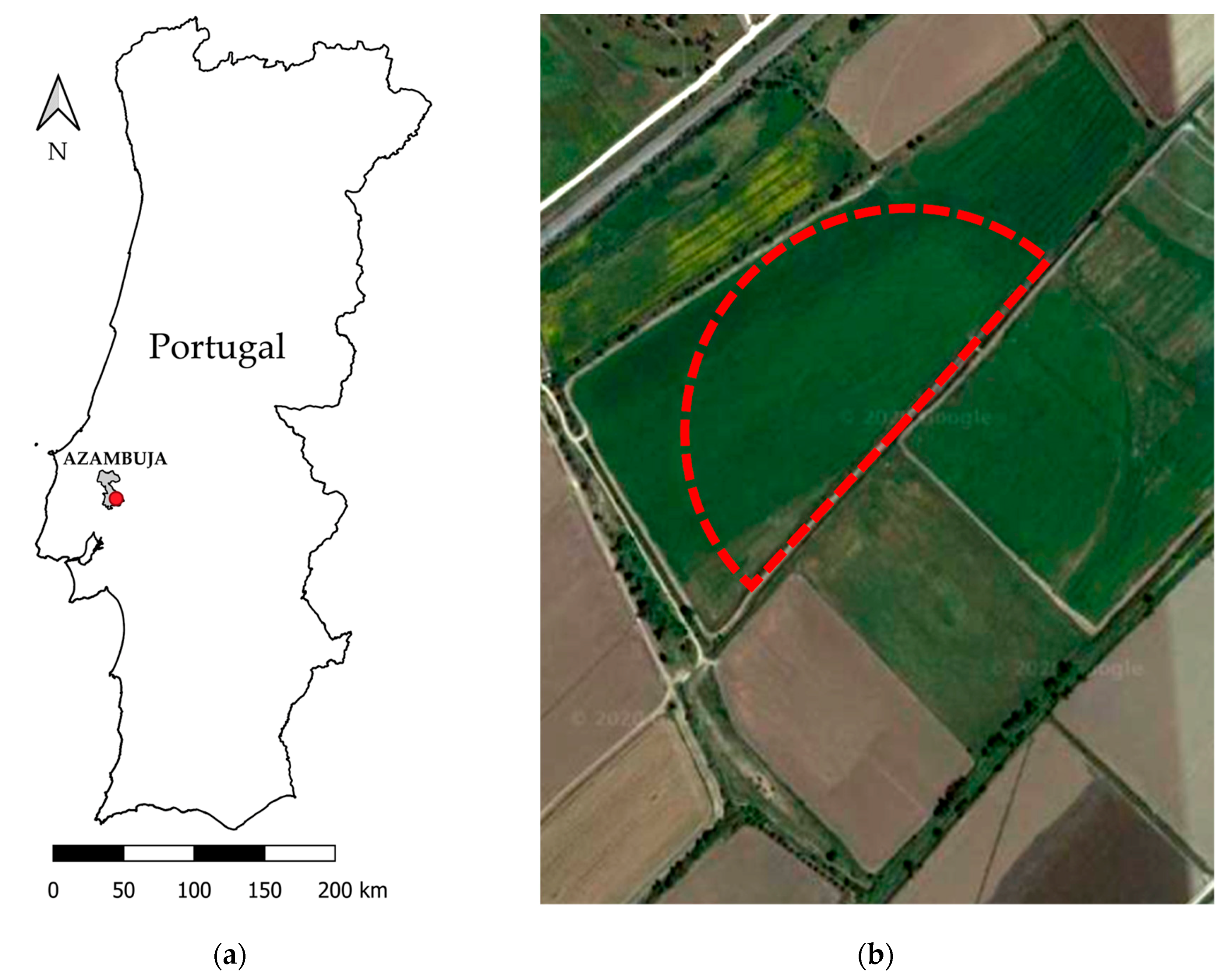

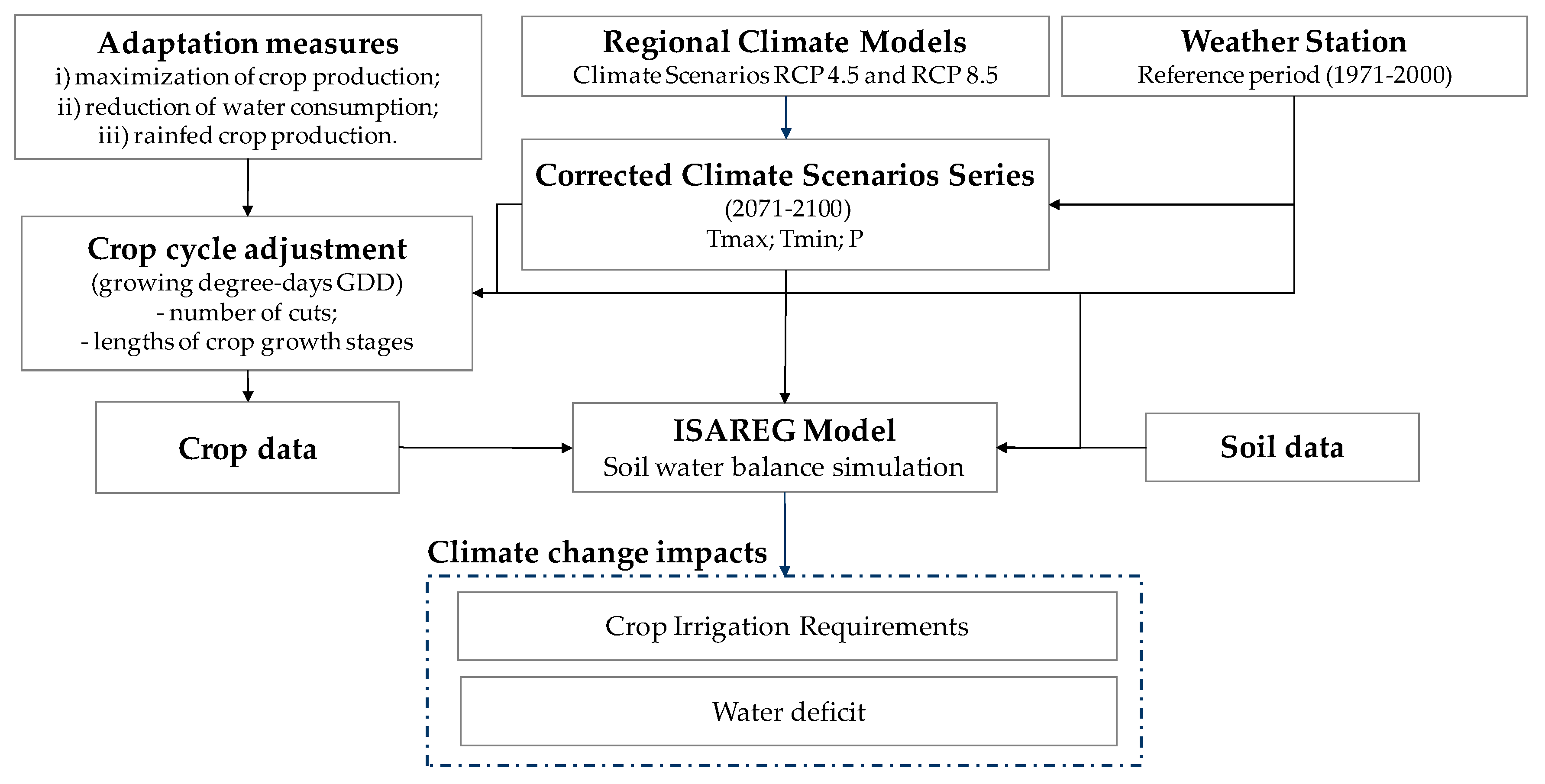
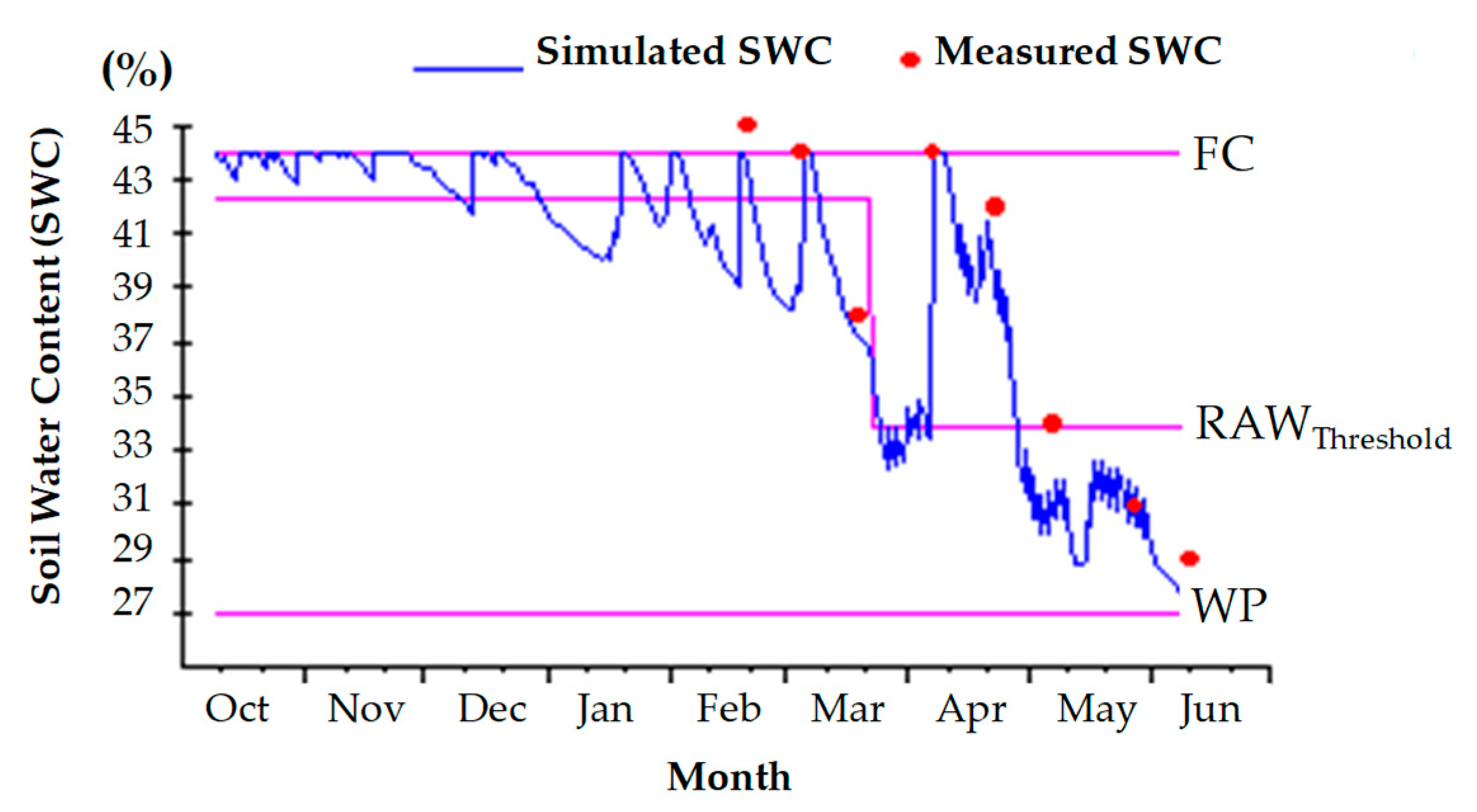

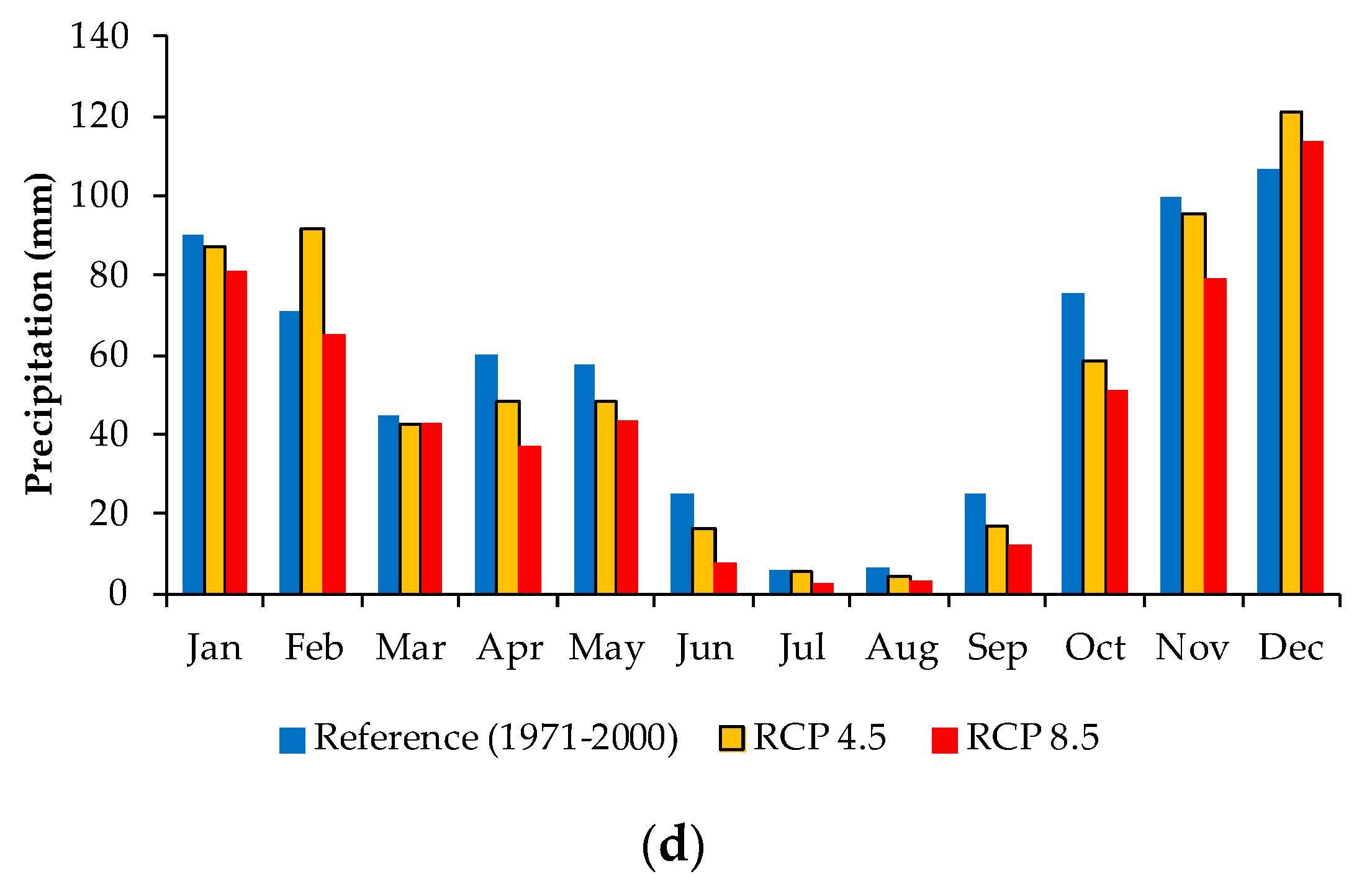
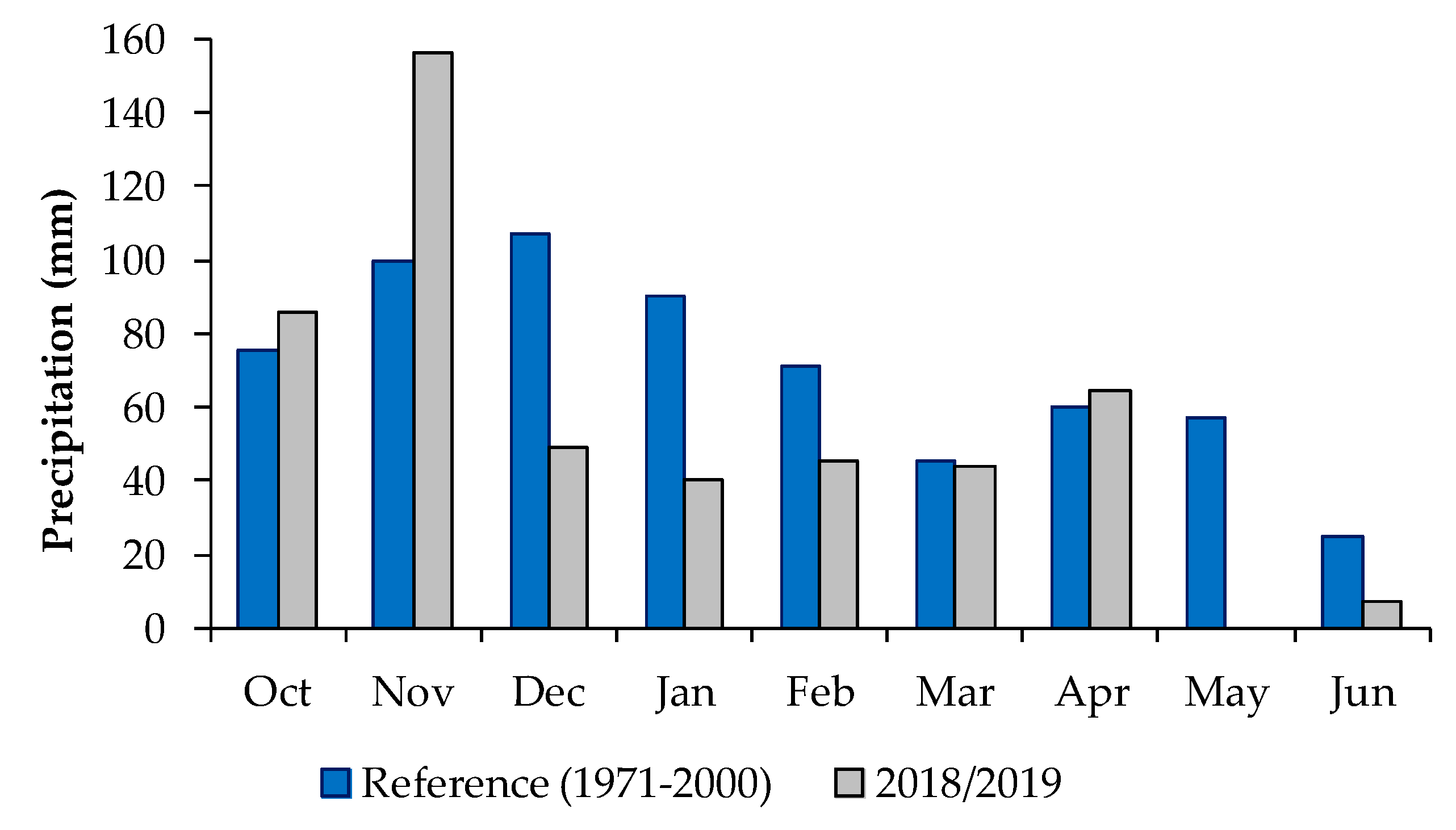
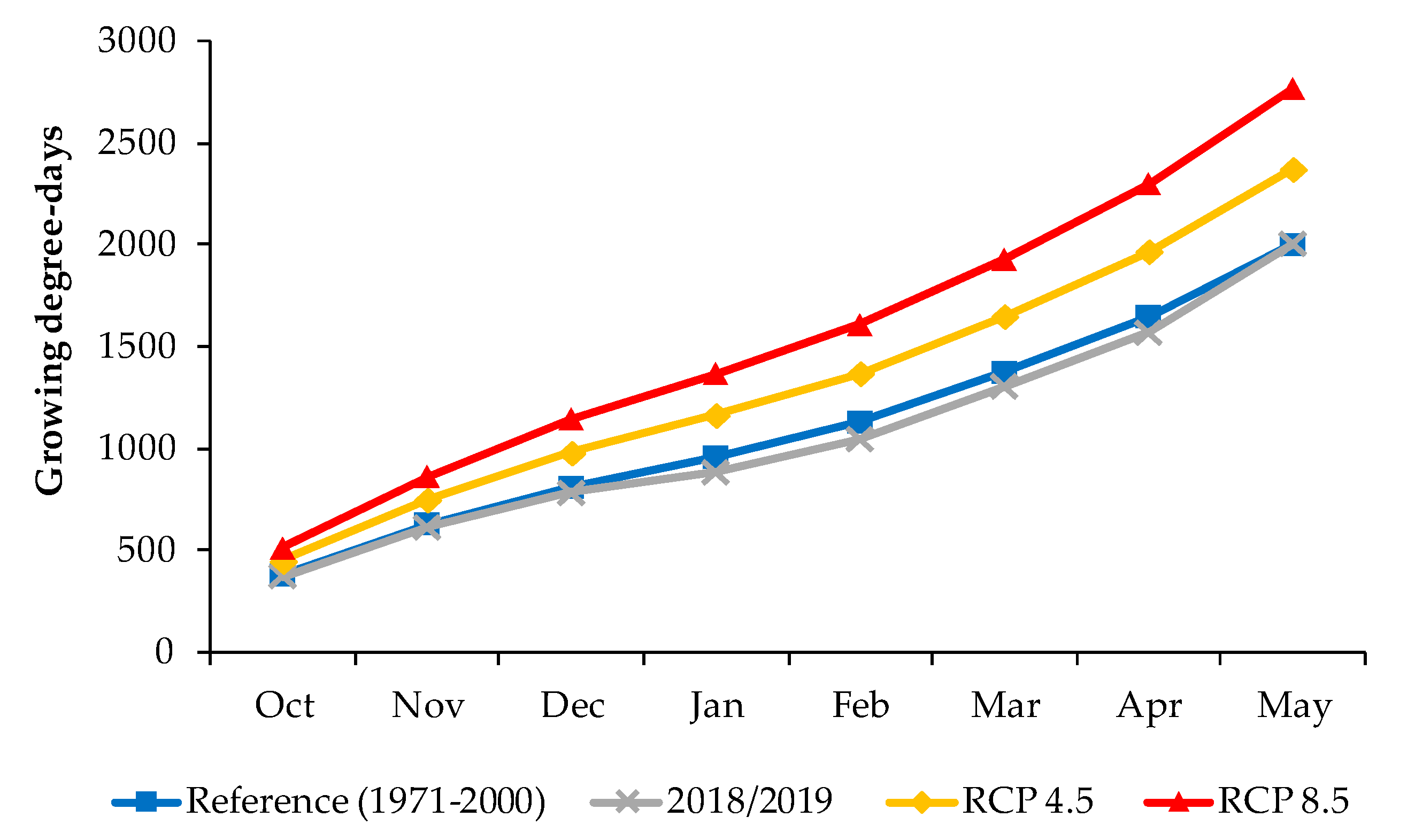

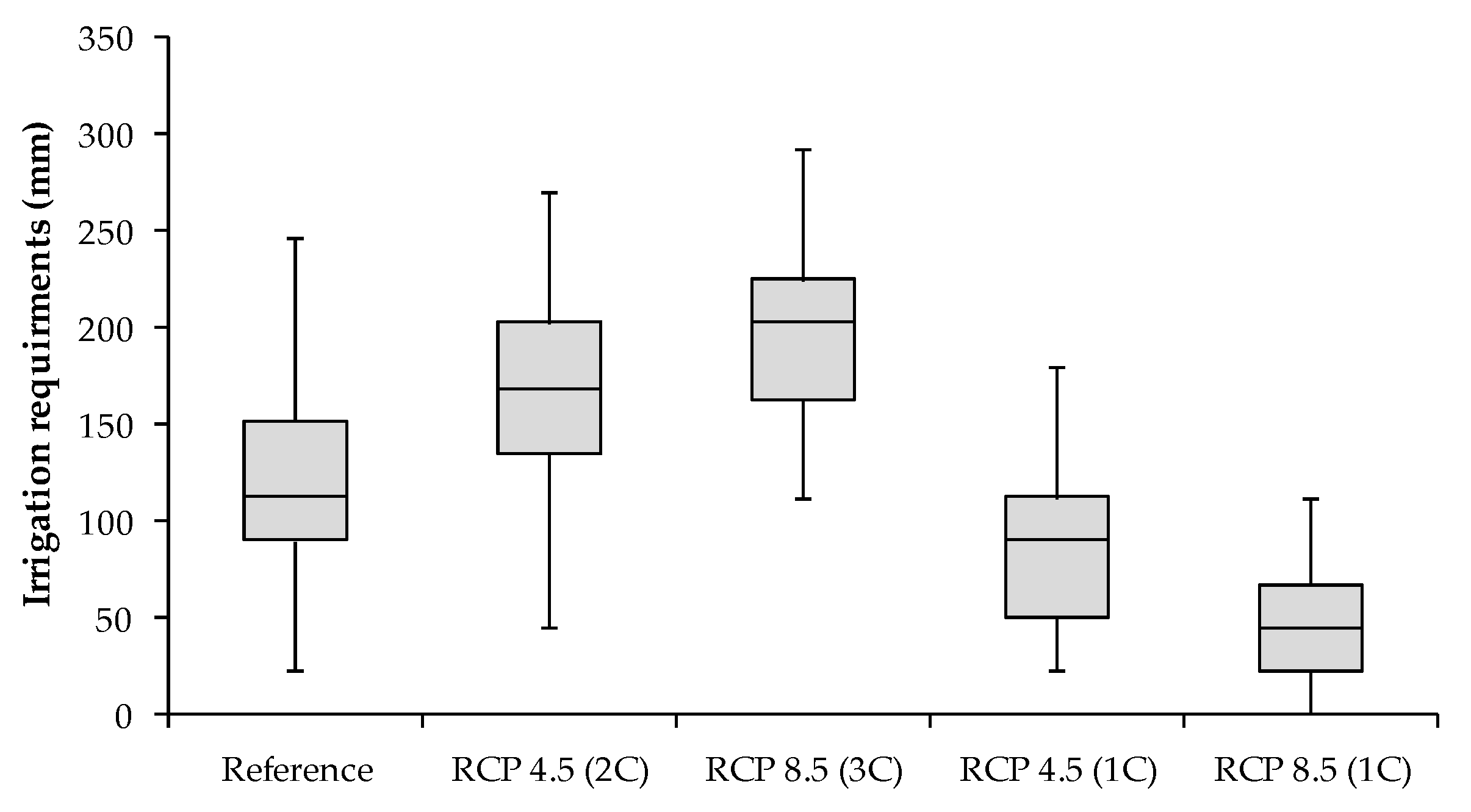
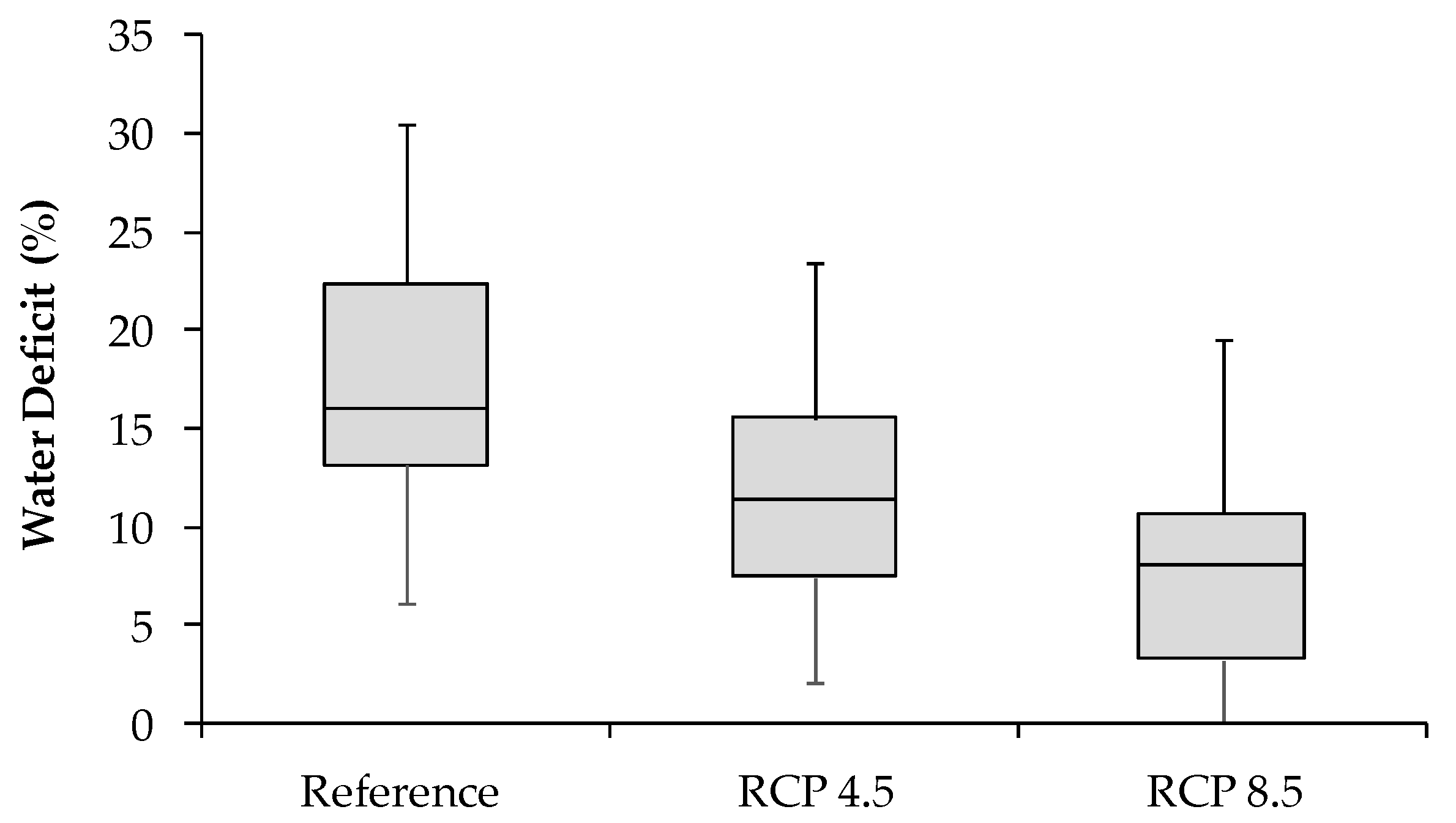
| Lolium multiflorum Lam. × Trifolium resupinatum L. | |||
|---|---|---|---|
| Reference Period | RCP 4.5 | RCP 8.5 | |
| Sowing day | 15 | 15 | 15 |
| Sowing month | 10 | 10 | 10 |
| Lini (days) | 30 (1C) | 27 (1C),16 (2C) | 23 (1C),14 (2C),12 (3C) |
| Ldev (days) | 135 (1C) | 117 (1C),23 (2C) | 103 (1C),22 (2C),18 (3C) |
| Lmid (days) | 40 (1C) | 35 (1C) | 30 (1C) |
| Llate (days) | 5 (1C) | 4 (1C) | 4 (1C) |
| Kc_ini | 0.3 | 0.3 | 0.3 |
| Kc_mid | 1.05 | 1.05 | 1.05 |
| Kc_end | 1 | 1 | 1 |
| Depletion fraction: p | 0.6 | 0.6 | 0.6 |
| Max. rooting depth (m) | 0.25 | 0.25 | 0.25 |
| Tavg Reference (°C) (1971–2000) | Anomaly RCP 4.5 (°C) (Tavg RCP 4.5–Tavg reference) | Anomaly RCP 8.5 (°C) (Tavg RCP 8.5–Tavg reference) | |
|---|---|---|---|
| January | 9.8 | 1.2 | 2.4 |
| February | 11.1 | 1.2 | 2.4 |
| March | 12.9 | 1.2 | 2.5 |
| April | 14.2 | 1.5 | 3.2 |
| May | 16.4 | 1.6 | 3.7 |
| June | 19.9 | 2.0 | 4.8 |
| July | 22.5 | 2.4 | 4.7 |
| August | 22.6 | 2.4 | 4.7 |
| September | 21.1 | 2.5 | 4.8 |
| October | 17.2 | 2.2 | 4.2 |
| November | 13.4 | 1.7 | 3.4 |
| December | 10.8 | 1.7 | 3.3 |
| Mean | 16 | 1.8 | 3.7 |
| Fist Cut | Second Cut | Third Cut | |||||
|---|---|---|---|---|---|---|---|
| Sowing | Harvesting | GDD | Harvesting | GDD | Harvesting | GDD | |
| Reference (1971–2000) | 15/October | 15/May | 1623 | - | - | - | - |
| 2018–2019 | 15/October | 23/March * | 1118 | 12/May | 500 | 13/June | 445 |
| RCP 4.5 (2071–2100) | 15/October | 17/April | 1601 | 26/May | 477 | - | - |
| RCP 8.5 (2071–2100) | 15/October | 25/March | 1603 | 01/May | 448 | 31/May | 453 |
Publisher’s Note: MDPI stays neutral with regard to jurisdictional claims in published maps and institutional affiliations. |
© 2020 by the authors. Licensee MDPI, Basel, Switzerland. This article is an open access article distributed under the terms and conditions of the Creative Commons Attribution (CC BY) license (http://creativecommons.org/licenses/by/4.0/).
Share and Cite
Soares, D.; Rolim, J.; Fradinho, M.J.; Paço, T.A.d. Climate Change Impacts on Irrigation Requirements of Preserved Forage for Horses under Mediterranean Conditions. Agronomy 2020, 10, 1758. https://doi.org/10.3390/agronomy10111758
Soares D, Rolim J, Fradinho MJ, Paço TAd. Climate Change Impacts on Irrigation Requirements of Preserved Forage for Horses under Mediterranean Conditions. Agronomy. 2020; 10(11):1758. https://doi.org/10.3390/agronomy10111758
Chicago/Turabian StyleSoares, Daniela, João Rolim, Maria João Fradinho, and Teresa Afonso do Paço. 2020. "Climate Change Impacts on Irrigation Requirements of Preserved Forage for Horses under Mediterranean Conditions" Agronomy 10, no. 11: 1758. https://doi.org/10.3390/agronomy10111758
APA StyleSoares, D., Rolim, J., Fradinho, M. J., & Paço, T. A. d. (2020). Climate Change Impacts on Irrigation Requirements of Preserved Forage for Horses under Mediterranean Conditions. Agronomy, 10(11), 1758. https://doi.org/10.3390/agronomy10111758








